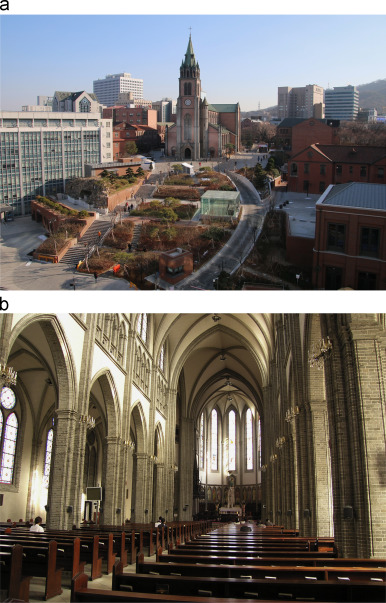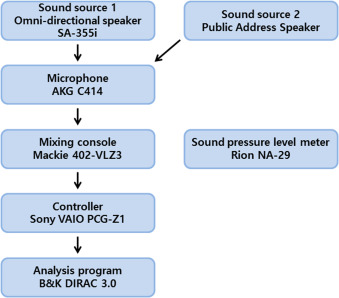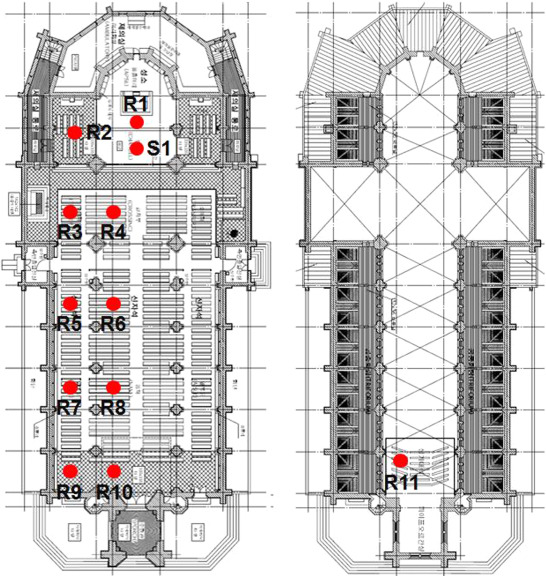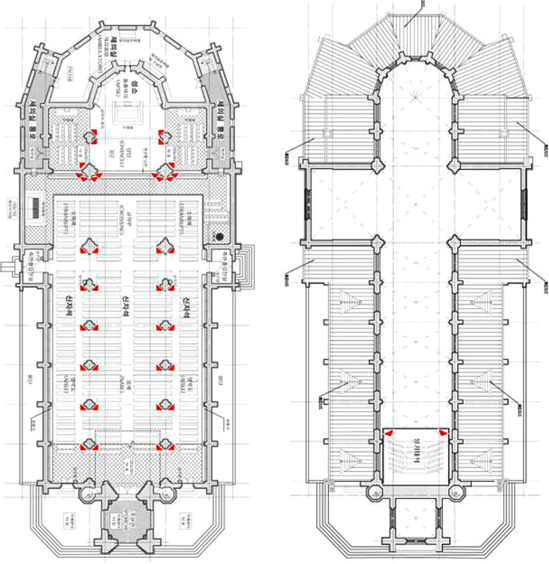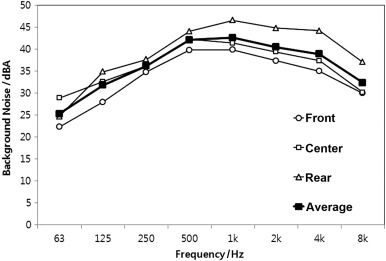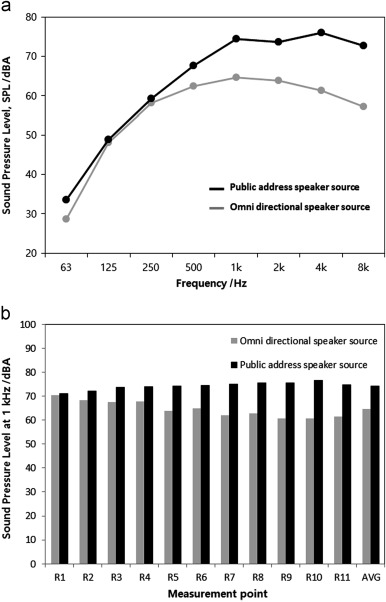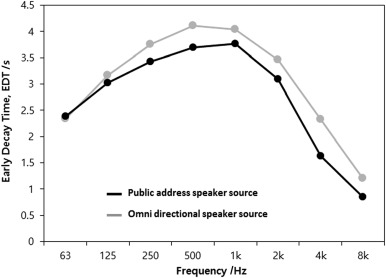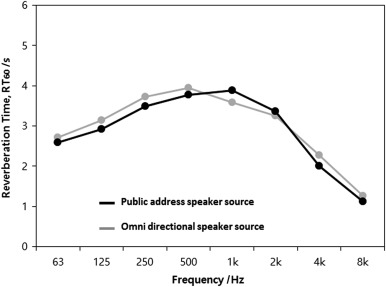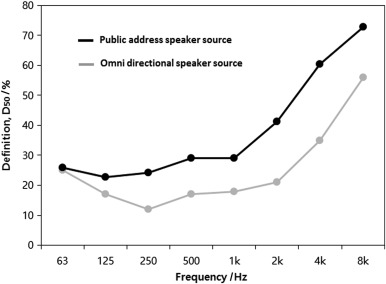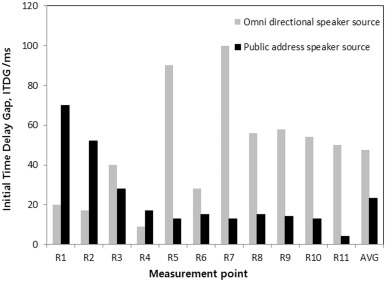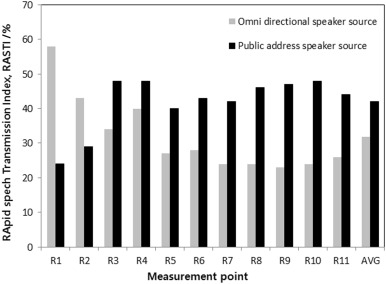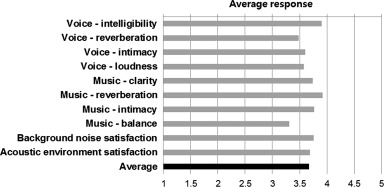Abstract
In the present study, improving acoustical characteristics of a Gothic cathedral (Myeong-dong Cathedral, which is the first built Western Gothic-style architecture in Korea) using simple public address system were investigated. Acoustical measurements were conducted at 11 selected points inside the cathedral and seven acoustical parameters were calculated: sound pressure level (SPL): 64.6 dBA (the measurement value with regard to the omni-directional speaker sound source); 74.5 dBA (the measurement value with regard to the public address speaker sound source), early decay time (EDT): 4.04 s; 3.76 s, reverberation time (RT60 ): 3.58 s; 3.89 s, clarity (C80 ): −6.2 dB; −2.8 dB, definition (D50 ): 18%; 29%, initial time delay gap (ITDG): 47 ms; 23 ms, and rapid speech transmission index (RASTI): 32%; 42%. Parameters showed that the acoustical characteristics of a typical Gothic cathedral include rich reverberation and diffusive sound fields. Meanwhile, there was improved speech intelligibility when using simple public address system. Based on subjective evaluation, there was overall satisfaction with voice and music recognition and the highest satisfaction with clarity with respect to voice recognition and with reverberation with respect to music recognition. This is a good solution of optimized acoustic environment through harmony between natural reverberation and reinforced clarity using simple public address system.
Keywords
Gothic cathedral ; Acoustical characteristics ; Public address system ; Clarity ; Reverberation
1. Introduction
Cathedral architecture is expressed by architectural shapes and structures as religious context is combined with socio-cultural backgrounds. The shape and structure inside a cathedral not only represent religious spatiality but also determine acoustical characteristics as a primary element (Scott, 2003 ; [19] ; Lim, 2006 ; Kilde, 2008 ). In recent years, a number of studies have been conducted on the architectural design, structures, materials, and conservation of cathedrals from various viewpoints (D׳Agostino D., 2013 ; Bartoli et al ., 2012 ; García-Diego, 2010 ; Coronelli and Caggioni, 2015 ; Bersani 2014 ; García-Diego and Zarzo, 2010 ; Imposa and Mele, 2011 ; Bartoli et al ., 2012 ; Webb and Brown, 2016 ). However, few studies have been conducted on the acoustical characteristics of cathedrals. In particular, studies on the acoustical characteristics of representative cathedrals that are world cultural heritages are rare. A study on the architectural acoustics of the Basilica Lateranense in the Vatican and the Basilica of St. Paul Outside the Walls (Raes and Sacerdote, 1953 ) and a study on the reverberation time by location inside St. Peter׳s Basilica in the Vatican (Shankland and Shankland, 1971 ) are a few of the typical studies on acoustical characteristics. However, such studies, which used early methodologies of acoustic study, seem lacking in precision of contents compared to that by today׳s systematic methodology using state-of-the-art measurement devices. Recently, various acoustical measurements and prediction methods based on humanistic considerations of the acoustical characteristics of cathedrals have been reported (Carvalho and Lencastre, 2000 ; Stepan et al ., 2003 ; Galindo et al ., 2005 ; Martellotta et al ., 2009 ; Brezia, 2014 ; Suárez et al ., 2015 ; Álvarez-Morales et al ., 2016 ).
Meanwhile, studies on the acoustical characteristics of cathedrals in Asia as Christianity propagated are even scarcer. Until recently, there have been only a few studies on the acoustical characteristics of cathedrals: reverberation and clarity (C80 ) in cathedrals and Protestant churches in Hong Kong (Chu and Maka, 2009 ) and acoustical characteristics by location of the sound source in cathedrals in Nagasaki, Japan (Soeta et al., 2012 ).
The foremost value in cathedral architecture is the appropriate structure for religious architecture and large space; hence, shapes, sizes, and finishing materials inside the buildings, which can determine the acoustical characteristics, are very difficult to change. In this regard, it is necessary to overcome acoustic limitations, and various methods using a public address system based on electro acoustics have been proposed in recent years. Recently, studies on practical research on acoustic designs of cathedrals around Europe have been underway and are mainly about the harmony of architectural acoustics and electro acoustics characteristics. Some of the typical studies propose a prediction model to improve acoustical characteristics in cathedrals of Apulia in Italy (Cirillo and Martellotta, 2003 ) and the acoustical characteristics according to speaker location in cathedrals in Tudela, Spain (Arana et al., 2008 ), and complement the public address system in a cathedral in Münster, Germany (Behler and Vorländer, 2013 ).
Roman Catholicism was brought to Korea 230 years ago and a cathedral following the Western style architecture was built in Myeong-dong, Seoul in 1898, which is now known as Myeong-dong Cathedral. This building was the first of Gothic architecture in Korea and is now listed as one of the modern cultural heritages in Korea. Myeong-dong Cathedral is a representative religious building of the Korean Catholic Church and regarded as architecturally legitimate because it was built under the supervision of French missionaries.
Because of its Gothic-style architecture, Myeong-dong Cathedral was selected to study its acoustical characteristics. The architectural acoustics and electro acoustics characteristics were compared and analyzed using acoustical measurements. This study was conducted as follows: investigation of construction specifications and indoor finishing materials of the Myeong-dong Cathedral, acoustical measurements in the cathedral with regard to an omni-directional speaker sound source and the public address system sound source based on ISO 3382-1 (ISO, 2009 ) and calculation of the acoustical parameters, comparison and analysis on acoustical parameters with regard to the two sound sources, and subjective evaluation of the acoustical characteristics and satisfaction of the congregation of the cathedral with regard to the two sound sources.
2. Acoustical measurements and subjective evaluation
2.1. Construction specifications and indoor finishing materials
Myeong-dong Cathedral, located at 1-1 Myeong-dong 2 ga, Jung-gu, Seoul, Korea, was registered as National Historic Site No. 258. The cathedral was built from August 5, 1892 to May 29, 1898. The cathedral has a one-story basement and a two-story building made from brick and masonry in the Gothic style. Its total length, width, and height are 67.7 m, 29.0 m, and 50.5 m, respectively. The floor area is 1,398.9 m2 and gross floor area is 2,182.5 m2 (including public transept). Fig. 1 (a) shows the panoramic view of Myeong-dong Cathedral and Fig. 1 (b) shows the indoor view of the cathedral.
|
|
|
Fig. 1. (a) Panoramic view; (b) Indoor view of Myeong-dong Cathedral (image courtesy of the official website of Myeong-dong Cathedral: http://www.mdsd.or.kr ). |
Table 1 shows the indoor finishing materials, which are main factors in terms of architectural acoustics, of each room of the cathedral. The materials used are stone tiles for the nave and floor in the side aisles, except for the front of the cathedral, including the altar; masonry bricks, gypsum plaster, and stained glass for walls and most columns; and gypsum plaster decorated in the vault ceiling for the ceiling part. The indoor finishing materials acted as reflectors whose absorption coefficients are low. Note that wooden floor, carpet, and long chairs for the congregation are internal finishing materials that have relatively high absorption coefficients (Cultural Heritage Administration of Korea, 2002 ).
| Room | Floor | Wall | Ceiling |
|---|---|---|---|
| Nave, Aisle | Imitation stone, Wooden chair, Tile (200×200 mm2 ) | Masonry brick, Stained glass | Gypsum plaster |
| Chancel | Wooden floor, Carpet, Tile (230×200 mm2 ) | Masonry brick | Gypsum plaster |
| Transept (East) | Wooden floor, Tile (160×160 mm2 ; altar part) | Masonry brick | Gypsum plaster |
| Transept (West) | Imitation stone, Tile (220×220 mm2 ; stoups part) | Masonry brick | Gypsum plaster |
| Side entrance | Tile (24×24 mm2 ) | Masonry brick | Gypsum plaster |
| Apse - Ambulatory | Wooden floor | Masonry brick | Gypsum plaster |
| Apse - Passage | Wooden floor | Masonry brick | Gypsum plaster |
2.2. Acoustical measurements method and details
The acoustical measurements were conducted based on ISO 3382-1. Multi-MLS (maximum length sequence) was generated by an omni-directional loud speaker as a sound source based on the DIRAC 3.0 acoustical analysis program of B&K, and seven acoustical parameters were calculated, including sound pressure level (SPL), early decay time (EDT), reverberation time (RT60 ), clarity (C80 ), definition (D50 ), initial time delay gap (ITDG), and rapid speech transmission index (RASTI). Fig. 2 shows the setup used for the measurements.
|
|
|
Fig. 2. Setup for the acoustical measurements. |
The measurements were conducted while the inside was empty, and indoor temperature and humidity were 17 °C and 35%. The location of the sound source and the number of measurement points were determined by considering the space size and shapes. The sound source was installed at the center (S1) of the altar in the ground floor, and the 11 measurement points were set on one side considering the symmetrical shape of Latin cross. In addition, considering that major religious rites are conducted using a public address system, 38 speakers of 30 W output power, installed at approximately 1.5 m height in the main columns in the nave on the ground floor and in the auxiliary columns in the side aisle, in addition to two speakers installed at the upper end of both front sides in the choir in the upper floor, were used as a sound source to measure the acoustical parameters in the cathedral.
The measurement points were divided into three sections: altar area (R1, R2), cathedral nave and side aisles (R3–R10), and choir in the upper floor (R11). The height of the measurement point was set to 1.2 m, and an omni-directional measurement microphone was used. Fig. 3 shows sound source and measurement points and Fig. 4 shows installed column speaker points.
|
|
|
Fig. 3. Sound source and measurement points (ground floor of the cathedral and upper floor). |
|
|
|
Fig. 4. Installed column speaker points (ground floor of the cathedral and upper floor). |
2.3. Subjective evaluation
Independent of the acoustical measurements, subjective evaluation was conducted through a questionnaire on the sound environment of the cathedral. Five hundred and nineteen believers familiar with the cathedral at the usual Sunday Mass time assessed their satisfaction regarding the sound environment and their satisfaction regarding the sound environment when applying the public address system into the category of the speech and music perception. In conclusion, the correlation between the acoustical parameters and results of the subjective evaluation was analyzed using statistical techniques.
The survey for the evaluation consisted of ten questions in total: four questions for voice recognition - speech intelligibility, reverberation, intimacy, and loudness; four questions for music recognition - clarity, reverberation, intimacy, and balance between low and high sound in music; and two questions for overall satisfaction - satisfaction about background noise and satisfaction about sound.
In the survey, a 5-point scale (1 very negative, 2 negative, 3 average, 4 positive, 5 very positive for satisfaction rating) was used, and the survey questionnaires were filled out by the subjects who were informed about the questions during mass in advance. The population distribution of the 519 subjects was 165 males and 354 females, and the age distribution ranged from teens to 60 s. Among them, subjects in their 20 s and 30 s were the largest group and accounted for 78.2% of the subjects.
3. Results of the acoustical measurement
3.1. Background noise and comparison of the SPL, EDT, and RT60
Fig. 5 shows measurement results (the value of each measurement point and the average value of three measurement points) of the background noise per frequency measured at the front, center, and rear of the center aisle in the ground floor of Myeong-dong Cathedral. The average value was 42.6 dBA at 1 kHz and relatively loud noise was measured at a frequency band from 500 Hz to 2 kHz. In particular, the rear area of the cathedral, which was adjacent to the main entrance, showed high background noise compared to that of the front and center areas of the center aisle, which was due to the effect of noise introduced from the cathedral square.
|
|
|
Fig. 5. Measured background noise of the cathedral. |
Fig. 6 (a) shows measurement results (the average value of 11 measurement points) of the SPL. SPL with regard to the omni-directional speaker sound source was 64.6 dBA on average at 1 kHz. Only the R1 area in the altar, which was close to the sound source, had an SPL greater than 70 dBA. Attenuation was discovered in the frequency band over 2 kHz. Meanwhile, SPL measured with regard to the public address speaker sound source was 74.5 dBA on average at 1 kHz, which was 10 dBA or higher than that of the omni-directional speaker sound source over the frequency band above 1 kHz.
|
|
|
Fig. 6. (a). Comparison of the SPL between the public address speaker sound source and the omni-directional speaker sound source. (b). Comparison of the SPL at 1 kHz between the public address speaker sound source and the omni-directional speaker sound source by each measurement point. |
The reference level was set to 80 dBA according to the SPL meter measurement results taken from 1 m in front of each speaker, with manual adjustments of the amplifier that generated the omni-directional speaker and the public address speaker that was used as sound source before the sound pressure level measure. This was because Myeong-dong Cathedral׳s public address system׳s volume level is set to 80 dBA, and other adjustments were impossible due to facility management. However, the manually adjusted and fixed reference level was perceived to have limited reliability. Thus, comparing the absolute value of the difference between two sound pressure levels could have been meaningless. Moreover, the opponent value between two sound pressure levels was analyzed and presented in Fig. 6 (b). Each measurement point of the sound pressure level׳s 1 kHz base distribution shows that the public address speaker sound source was relatively greater than or equal to the sound pressure level for almost every measurement point.
Fig. 7 shows measurement results (the average value of 11 measurement points) of the EDT. Measured EDT with regard to the omni-directional speaker sound source was 4.04 s on average at 1 kHz, and the center and rear areas (R5–R11) of the cathedral showed EDT above 4.00 s on average over the entire frequency band. The results showed an increasing tendency as they grew close to the rear. Meanwhile, measured EDT with regard to the public address speaker sound source was 3.76 s on average at 1 kHz, and the EDT were slightly shorter than that of the omni-directional speaker sound source over the frequency band above 250 Hz.
|
|
|
Fig. 7. Comparison of the EDT between the public address speaker sound source and the omni-directional speaker sound source. |
Fig. 8 shows measurement results (the average value of 11 measurement points) of the RT60 . Measured RT60 with regard to the omni-directional speaker sound source was 3.58 s on average at 1 kHz, and rich reverberation was found over 3.00 s on average over the entire frequency band in all measurement points. Rapid attenuation was found in the frequency band over 2 kHz. Meanwhile, measured RT60 with regard to the public address speaker sound source was 3.89 s on average at 1 kHz, and the resulting tendency was similar to the measurement result with regard to omni-directional speaker sound source.
|
|
|
Fig. 8. Comparison of the RT60 between the public address speaker sound source and the omni-directional speaker sound source. |
3.2. Comparison of the C80, D50, ITDG, and RASTI
Fig. 9 shows measurement results (the average value of 11 measurement points) of the C80 . Measured C80 with regard to the omni-directional speaker sound source was −6.2 dB on average at 1 kHz, and only two points, R1 and R2 near the altar, which were close to the sound source, were close to 0 dB. This result significantly deviated from ±2 dB proposed by Jordan as an appropriate value (Jordan, 1970 ). Meanwhile, measured C80 with regard to the public address speaker sound source was −2.8 dB on average at 1 kHz, and the result showed better clarity overall compared to that of the omni-directional speaker sound source. This result is close to the range of ±2 dB proposed by Jordan as an appropriate value.
|
|
|
Fig. 9. Comparison of the C80 between the public address speaker sound source and the omni-directional speaker sound source. |
Fig. 10 shows measurement results (the average value of 11 measurement points) of the D50 . Measured D50 with regard to the omni-directional speaker sound source was 18% on average at 1 kHz. Similar to the result for C80 , all points, except R1 and R2 around the altar, which were close to the sound source, showed significantly lower values than appropriate values such as 30–40% for concert halls and 55–60% for multi-purpose halls (Barron, 2010 ). Meanwhile, measured D50 with regard to the public address speaker sound source was 29% on average at 1 kHz, and the result showed better definition overall compared to that of the omni-directional speaker sound source. In particular, more than 30% of definition was shown in the frequency band over 500 Hz, which met the definition of the appropriate value of 30–40% for concert halls and 55–60% for multi-purpose halls.
|
|
|
Fig. 10. Comparison of the D50 between the public address speaker sound source and the omni-directional speaker sound source. |
Fig. 11 shows measurement results (the value of each measurement point) of the ITDG. The measured ITDG with regard to the omni-directional speaker sound source was 47 ms on average over all points, and relatively high values were found in the external measurement points (R3, R5, R7) at the side aisle in the cathedral. This result was obtained because the large number of main columns in the aisle and auxiliary columns in the transept along with the side walls and the stained glass acted as main reflectors, thereby creating a large deviation between direct sound and initial reflective sound. Meanwhile, measured ITDG with regard to the public address speaker sound source was 23 ms on average over the points, and all measurement points, except R1 and R2 near the altar close to the sound source, showed low values. This is a different tendency from that found with the omni-directional speaker sound source, which was due to the reduced deviation between direct sound and initial reflective sound caused by direct sound transmitted from 40 speakers installed densely at the sitting height of the congregation around the main columns in the cathedral. On the contrary, ITDG at R1 and R2 was high, which was due to the increase in deviation between direct sound and initial reflective sound as a result of characteristics of the altar, where no additional speaker was installed.
|
|
|
Fig. 11. Comparison of the ITDG between the public address speaker sound source and the omni-directional speaker sound source. |
Fig. 12 shows measurement results (the value of each measurement point) of the RASTI. Measured RASTI with regard to the omni-directional speaker sound source was 32% on average over the points, and all measurement points, except R1, which is near the altar close to the sound source, were evaluated as having bad efficiency. This was due to the effect of rich reverberation time caused by the large space, numerous columns, and reflective finishing materials, which are the unique characteristics of Gothic-style cathedrals as found in the analysis on C80 and D50 . Meanwhile, measured RASTI with regard to the public address speaker sound source was 42% on average over all points, and the result showed better RASTI overall compared to that of the omni-directional speaker sound source. This was due to the complement to the long reverberation time caused by a large deviation between direct sound and initial reflective sound, thanks to the simple application of the public address system, as shown in comparison with measurement results for ITDG. This result was also consistent with the tendency of C80 and D50 , which showed better clarity than that using the omni-directional speaker sound source. However, R1 and R2 in the altar, where no additional speaker was installed, showed a relatively low efficiency.
|
|
|
Fig. 12. Comparison of the RASTI between the public address speaker sound source and the omni-directional speaker sound source. |
4. Results of the subjective evaluation
The response of the subjects on the evaluation is shown in Fig. 13 . The scores ranged between 3.31 and 3.92, and the overall average was 3.68, which indicated that subjects were satisfied overall with the sound environment (voice and music recognition and background noise) in Myeong-dong Cathedral. The only parameter that had below the average satisfaction was balance between low and high sounds in music recognition.
|
|
|
Fig. 13. Subjective evaluation results on satisfaction rating about sound environment of the cathedral. |
The most noticeable results were the highest satisfaction rating for speech intelligibility for the voice recognition and reverberation of sound in the music recognition. This result is regarded as an optimized acoustic environment for Catholic Churches performing mass and religious rites officially given that voice and music are heard in the same space simultaneously. This is because the highest satisfaction was shown in clarity of voice and music reverberation.
Pearson׳s correlation coefficients between the acoustical parameters and results of the subject evaluation in Myeong-dong Cathedral were calculated to examine the relationship between the quantitative data and the qualitative data, and the results are listed in Table 2 .
| Subject | Acoustical parameters | ||||||
|---|---|---|---|---|---|---|---|
| SPL | EDT | RT60 | C80 | D50 | ITDG | RASTI | |
| Voice – intelligibility | 0.62* | −0.49 | −0.07 | 0.70* | 0.61* | −0.78** | 0.50 |
| Voice – reverberation | −0.07 | −0.11 | −0.19 | −0.03 | 0.04 | −0.26 | 0.13 |
| Voice – intimacy | 0.51 | −0.41 | 0.12 | 0.44 | 0.37 | −0.29 | 0.32 |
| Voice – loudness | −0.12 | 0.17 | 0.16 | −0.11 | −0.14 | 0.05 | −0.08 |
| Music – clarity | −0.47 | 0.43 | 0.67* | 0.43 | −0.46 | 0.08 | −0.50 |
| Music – reverberation | −0.69* | 0.74** | 0.44 | 0.62* | −0.68* | 0.36 | −0.73* |
| Music – intimacy | −0.57 | 0.61* | 0.62* | −0.52 | −0.60* | 0.35 | −0.61* |
| Music – balance | −0.26 | 0.25 | 0.21 | −0.17 | −0.25 | 0.25 | −0.28 |
- . p <0.05.
- . p <0.01.
In terms of speech intelligibility for the voice recognition, the acoustical parameters were significantly correlated with “Voice – intelligibility,” while the acoustical parameters are not significantly correlation with “Voice – reverberation,” “Voice – intimacy,” and “Voice – loudness.”.
There was positive correlation between “Voice – intelligibility” and SPL, C80 , and D50 (correlation coefficients are 0.62, 0.70, and 0.61, respectively), while there was a negative correlation between “Voice – intelligibility” and ITDG (correlation coefficient is −0.78). One explanation for this is that people׳s perception of speech intelligibility was influenced positively by favorable sound pressure levels and voice clarity, whereas it was influenced negatively by the initial reverberation.
With regard to reverberation of sound in the music recognition, the acoustical parameters were significantly correlated with “Music – clarity,” “Music – reverberation,” and “Music – intimacy,” while the acoustical parameters are not significant correlation with “Music – balance.”
A positive correlation was found between “Music – clarity” and RT60 (correlation coefficient is 0.67). There was positive correlation between “Music – reverberation” and EDT and C80 (correlation coefficients are 0.74 and 0.62, respectively), while there was a negative correlation between “Music – reverberation” and SPL, D50 , and RASTI (correlation coefficient are −0.69, −0.68, and −0.73, respectively).
In addition, positive correlations were found between “Music – intimacy” and EDT and RT60 (correlation coefficients are 0.61 and 0.62, respectively), while negative correlations were found between “Music – intimacy” and D50 and RASTI (correlation coefficients are –0.60 and −0.61, respectively). One explanation for this is that people׳s perception of reverberation of sound was influenced positively by favorable reverberation and music clarity, whereas it was influenced negatively by sound pressure levels and voice clarity.
The similar tendencies were found between the acoustical parameters and results of the subjective evaluation by statistical analysis. It can be explained that speech intelligibility in the voice recognition was influenced positively by favorable sound pressure level (SPL) and clarity of voice (C80 and D50 ), whereas it was influenced negatively by the initial reverberation (ITDG). Meanwhile, reverberation of sound in the music recognition was influenced positively by favorable reverberation (EDT and RT60 ) and clarity of music (C80 ), whereas it was influenced negatively by sound pressure level (SPL) and clarity of voice (D50 ).
5. Concluding remarks
Seven acoustical parameters were calculated from the acoustical measurements conducted in Myeong-dong Cathedral, the Roman Catholic Archdiocese of Seoul, which is the first built Western Gothic-style architecture in Korea. The results were as follows: SPL (64.6 dBA on average), EDT (4.04 s on average), RT60 (3.58 s on average), C80 (−6.2 dB on average), D50 (18% on average), ITDG (47 ms on average), and RASTI (32% on average). Although the above results had considerably low efficiency in terms of sound pressure and clarity, they provided an appropriate acoustic environment for classical church music such as a monophonic chant, unaccompanied choral music, and pipe organ music in terms of reverberation time.
When application of simple public address system based on the electro acoustics installed at the cathedral, improved sound pressure and clarity (SPL, C80 , D50 , ITDG, and RASTI were improved significantly, excluding reverberation characteristics) can be acquired as follows: SPL (74.5 dBA on average), EDT (3.76 s on average), RT60 (3.89 s on average), C80 (−2.8 dB on average), D50 (29% on average), ITDG (23 ms on average), and RASTI (42% on average).
This can be explained in that acoustic problems derived from the long reverberation time caused by large space, a large number of columns, and masonry finishing materials in the unique Gothic cathedral architecture were supplemented through simple application of simple public address system. In fact, the public address system in Myeong-dong Cathedral designed with simple voice amplification devices such as audio power amplifiers (mono-channel 240 W amplifier 6EA), graphic equalizer (64-band analog graphic equalizer 4EA), and loud speakers (2-way 30 W column speaker 40EA; as shown Fig. 3 ), excluding a DSP (digital signal processor). This improvement can also be found in subjective evaluation survey results. Actually, there are similar tendencies on speech intelligibility for the voice recognition and reverberation of sound in the music recognition between the acoustical parameters and results of the subjective evaluation.
That is, the congregation in Myeong-dong Cathedral revealed their satisfaction as above average on the sound environment (voice and music recognition, background noise). A long reverberation time due to the indoor shape and finishing materials used in the cathedral increased satisfaction on music recognition, and voice amplification using the minimum public address system raised satisfaction on voice recognition.
This is a good solution of the supplementation of acoustic problems derived from the sound environment caused by the Gothic cathedral׳s architectural shape and structure, while preserving the above characteristics of Myeong-dong Cathedral, which is regarded as representative cultural heritage of Korea. Myeong-dong Cathedral has an optimized acoustic environment through harmony between natural reverberation, which is derived from the architectural acoustics originating from its architectural shape and structure, and clarity obtained thanks to the application of minimum public address system based on electro acoustics.
Acknowledgements
This research was supported by a grant (Religious Architecture Research Fund 2016-01 ) from Catholic architect office of Roman Catholic Archdiocese of Seoul, Korea . Additionally, the authors would like to thank RPG Korea Diffusor Systems, Inc. for technical cooperation.
References
- Álvarez-Morales et al., 2016 L. Álvarez-Morales, S. Girón, M. Galindo, T. Zamarreño; Acoustic environment of Andalusian cathedrals; Build. Environ, 103 (2016), pp. 182–192
- Arana et al., 2008 M. Arana, R. San Martin, M.L. San Martin; Influence of the source orientation on the measurement of acoustic parameters in a large reverberant cathedral; J. Acoust. Soc. Am., 123 (5) (2008), p. 3502
- Barron, 2010 M. Barron; Auditorium Acoustics and Architectural Design, 38–74, Spon Press Oxon, UK (2010), pp. 385–409
- Bartoli et al., 2012 G. Bartoli, M. Betti, L. Facchini, M. Orlando; Non-destructive characterization of stone columns by dynamic test: application to the lower colonnade of the Dome of the Siena Cathedral; Eng. Struct, 45 (2012), pp. 519–535
- Behler and Vorländer, 2013 G. Behler, M. Vorländer; Design of the new public address system for the cathedral of Münster, Germany; J. Acoust. Soc. Am., 133 (5) (2013), p. 3404
- Bersani 2014 Bersani, D., Berzioli, M., Caglio, S., Casoli, A., Lottici, P.P., Medeghini, L., Poldi, G., Zannini, P., 2014. An integrated multi-analytical approach to the study of the dome wall paintings by Correggio in Parma cathedral, Microchem. J. 114, 80–88.
- Brezia, 2014 P. Brezia; Measurement of intelligibility and clarity of the speech in Romanesque churches; J. Cult. Herit., 16 (3) (2014), pp. 386–390
- Carvalho and Lencastre, 2000 A.P.O. Carvalho, M.M.F. Lencastre; Catholic churches, sound-reinforcement systems and RASTI; Int. J. Acoust. Vibr., 5 (1) (2000), pp. 7–14
- Chu and Maka, 2009 Y. Chu, C.M. Maka; Early energy decays in two churches in Hong Kong; Appl. Acoust., 70 (4) (2009), pp. 2579–2587
- Cirillo and Martellotta, 2003 E. Cirillo, F. Martellotta; An improved model to predict energy-based acoustic parameters in Apulian-Romanesque churches; Appl. Acoust., 64 (1) (2003), pp. 1–23
- Coronelli and Caggioni, 2015 D. Coronelli, B. Caggioni, Zanella Francesca; Cathedral of Milan: structural history of the load-bearing system; Int. J. Archit. Herit, 9 (4) (2015), pp. 510–528
- Cultural Heritage Administration of Korea, 2002 Cultural Heritage Administration of Korea; Myeong-dong Cathedral Research Investigation Report; Cultural Heritage Administration of Korea (2002)
- D׳Agostino D., 2013 D׳Agostino, D., 2013. Moisture dynamics in an historical masonry structure: The Cathedral of Lecce (South Italy), Build. Environ. 63, 122–133.
- García-Diego and Zarzo, 2010 Fernando-Juan, Manuel Zarzo; Microclimate monitoring by multivariate statistical control: the renaissance frescoes of the Cathedral of Valencia (Spain); J. Cult. Herit., 11 (3) (2010), pp. 339–344
- García-Diego, 2010 García-Diego, F.J., Zarzo, M., 2010. Microclimate monitoring by multivariate statistical control: the renaissance frescoes of the Cathedral of Valencia (Spain), J. Cult. Herit.11 (3), 339–344.
- Galindo et al., 2005 M. Galindo, T. Zamarreno, S. Giron; Acoustic analysis in Mudejar-Gothic churches: experimental results; J. Acoust. Soc. Am., 117 (5) (2005), pp. 2873–2888
- Bartoli et al., 2012 Gianni, Michele Betti, Luca Facchini, Maurizio Orlando; Non-destructive characterization of stone columns by dynamic test: application to the lower colonnade of the Dome of the Siena Cathedral; Eng. Struct., 45 (2012), pp. 519–535
- International Standard Organization, 2009 International Standard Organization, 2009. ISO 3382-1, Acoustics – measurement of room acoustic parameters, part 1: Performance spaces, Geneve, Switzerland.
- Imposa and Mele, 2011 S. Imposa, G. Mele; Ground penetrating radar survey inside the S. Agata cathedral of Catania (Eastern Sicily); Int. J. Archit. Herit., 5 (2) (2011), pp. 188–197
- Jordan, 1970 V.L. Jordan; Acoustical criteria for auditoriums and their relation to model techniques; J. Acoust. Soc. Am., 47 (1970), pp. 408–412
- Kilde, 2008 J.H. Kilde; Sacred power, sacred space; Oxford University Press, Oxford, UK (2008), pp. 131–159
- [19] S.J. Lim; History of western architecture 2: christianity and human; Book House Publish, Seoul, Korea (2003)
- Lim, 2006 S.J. Lim; History of Western Architecture 3: Heaven and Human; Book House Publish, Seoul, Korea (2006)
- Martellotta et al., 2009 F. Martellotta, E. Cirillo, S. Carbonari, P. Ricciardi; Guidelines for acoustic measurement in churches; Appl. Acoust., 70 (2) (2009), pp. 378–388
- Raes and Sacerdote, 1953 A.C. Raes, G.G. Sacerdote; Measurements of the acoustical properties of two Roman basilicas; J. Acoust. Soc. Am., 25 (5) (1953), pp. 954–961
- Scott, 2003 R. Scott; The Gothic Enterprise, 121–133, University of California Press, Berkeley, CA (2003), pp. 147–170
- Shankland and Shankland, 1971 R.S. Shankland, H.K. Shankland; Acoustics of St. Peter׳s and Patriarchal Basilicas on Rome; J. Acoust. Soc. Am., 50 (2) (1971), pp. 389–396
- Soeta et al., 2012 Y. Soeta, K. Ito, R. Shimokura, S. Sato, T. Ohsawa, Y. Ando; Effects of sound source location and direction on acoustic parameters in Japanese churches; J. Acoust. Soc. Am., 131 (2) (2012), pp. 1206–1220
- Suárez et al., 2015 R. Suárez, A. Alonso, J.J. Sendra; Intangible cultural heritage: the sound of the Romanesque cathedral of Santiago de Compostela; J. Cult. Herit., 16 (2) (2015), pp. 239–243
- Stepan et al., 2003 Stepan, C., Christophers, C., Kang, J., 2003. Acoustic measurements and subjective survey in five churches in Sheffield. In: Proceedings of the Institute of Acoustics (IOA) (UK), 25 (7), 107–115.
- Webb and Brown, 2016 N. Webb, A. Brown; Digital re-analysis of lost architecture and the particular case of Lutyens׳ Liverpool Metropolitan Cathedral; Front. Arch. Res (2016), p. 2016
Document information
Published on 12/05/17
Submitted on 12/05/17
Licence: Other
Share this document
Keywords
claim authorship
Are you one of the authors of this document?
